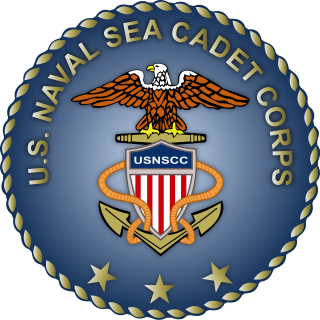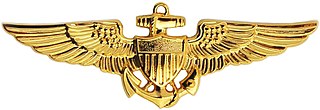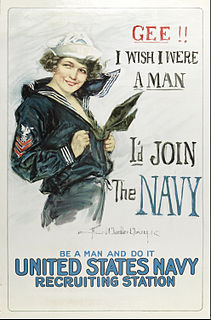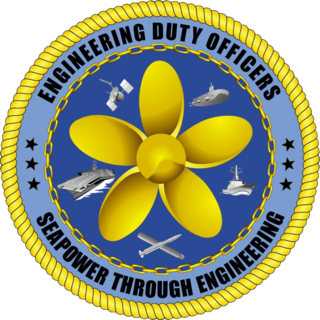
Lieutenant commander is a commissioned officer rank in many navies. The rank is superior to a lieutenant and subordinate to a commander. The corresponding rank in most armies and air forces is major, and in the Royal Air Force and other Commonwealth air forces is squadron leader.
In the United States Navy, officers have various ranks. Equivalency between services is by pay grade. United States Navy commissioned officer ranks have two distinct sets of rank insignia: On dress uniform a series of stripes similar to Commonwealth naval ranks are worn; on service khaki, working uniforms, and special uniform situations, the rank insignia are identical to the equivalent rank in the US Marine Corps.

Mess dress uniform is the semi-formal type of uniforms used by military personnel, police personnel, firefighters and other public uniformed services members for certain ceremonies, receptions, and celebrations, in messes or on private occasions. It frequently consists of a mess jacket, trousers, white dress shirt, often with standing collar and bow tie, along with orders and medals insignia. Design may depend on regiment or service branch, e.g. army, navy, air force, marines, etc. In Western dress codes, mess dress uniform is a permitted supplementary alternative equivalent to the civilian black tie for evening wear or black lounge suit for day wear - sometimes collectively called half dress - although military uniforms are the same for day and evening wear. As such, mess dress uniform is considered less formal than full dress uniform, but more formal than service dress uniform.

The United States Naval Sea Cadet Corps is a congressionally-chartered, U.S. Navy sponsored organization that serves to teach individuals about the sea-going military services, U.S. naval operations and training, community service, citizenship, and an understanding of discipline and teamwork. The USNSCC is composed of two programs – the senior program for cadets age 13 through the age of 18, and the Navy League Cadet Corps (NLCC), which is for cadets ages 10 through 13.

Insignias and badges of the United States Navy are military badges issued by the United States Department of the Navy to naval service members who achieve certain qualifications and accomplishments while serving on both active and reserve duty in the United States Navy. Most naval aviation insignia are also permitted for wear on uniforms of the United States Marine Corps.
In the United States Armed Forces, a line officer or officer of the line is a U.S. Navy or U.S. Marine Corps commissioned officer or warrant officer who exercises general command authority and is eligible for operational command positions, as opposed to officers who normally exercise command authority only within a Navy Staff Corps. The term line officer is also used by the U.S. Air Force and U.S. Coast Guard to indicate that an officer is eligible for command of operational, viz., tactical or combat units. The term is not generally used by officers of the U.S. Army – the roughly corresponding Army terms are basic branch and special branch, qualified officers, although the concepts are not entirely synonymous, as some Army special branch officers are eligible to hold command outside their branch specialty.

The Naval Reserve Officers Training Corps (NROTC) program is a college-based, commissioned officer training program of the United States Navy and the United States Marine Corps.

A naval aviator is a commissioned officer or warrant officer qualified as a pilot in the United States Navy, United States Marine Corps or United States Coast Guard.
Commodore was an early title and later a rank in the United States Navy, United States Coast Guard and the Confederate States Navy. For over two centuries, the designation has been given varying levels of authority and formality.

The uniforms of the United States Navy include dress uniforms, daily service uniforms, working uniforms, and uniforms for special situations, which have varied throughout the history of the navy. For simplicity in this article, officers refers to both commissioned officers and warrant officers.

The United States Maritime Service (USMS) was established in 1938 under the provisions of the Merchant Marine Act of 1936 as voluntary organization to train individuals to become officers and crewmembers on merchant ships that form the United States Merchant Marine per 46 U.S.C. § 51701. Heavily utilized during World War II, the USMS has since been largely dissolved and/or absorbed into other federal departments, but its commissioned officers continue to function as administrators and instructors at the United States Merchant Marine Academy and the several maritime academies.

These are the official Royal Navy Officer ranks ordered by rank. These ranks are part of the NATO/United Kingdom ranks, including modern and past. Past insignia is in italic.
In the United States Navy, commissioned officers are either line officers or staff corps officers. Staff corps officers are specialists in career fields that are professions unto themselves, such as physicians, lawyers, civil engineers, chaplains, and supply specialists. For example, a physician can advance to become the commanding officer (CO) of a hospital, the medical hospital on a hospital ship or large warship, or a medical school; or the Chief of the Medical Corps or of the Bureau of Medicine and Surgery. A supply officer can become the CO of a supply depot or a school, or the head of the Naval Supply Systems Command, etc.

In the United States Armed Forces, the ranks of warrant officer are rated as officers above all non-commissioned officers, candidates, cadets, and midshipmen, but subordinate to the lowest officer grade of O‑1. This application differs from the Commonwealth of Nations and other militaries, where warrant officers are the most senior of the other ranks, equivalent to the U.S. Armed Forces grades of E‑8 and E‑9.

The Uniforms of the United States Marine Corps serve to distinguish Marines from members of other services. Among current uniforms in the United States Armed Forces, the Marine Corps dress uniforms have been in service the longest. The Marine Dress Blue uniform has, with few changes, been worn in essentially its current form since the late 19th century.

The Civil Engineer Corps (CEC) is a staff corps of the United States Navy. CEC officers are professional engineers and architects, acquisitions specialists and Seabee Combat Warfare Officers. They are responsible for executing and managing the planning, design, acquisition, construction, operation, and maintenance of the Navy's shore facilities. The Civil Engineer Corps is under the command of the Chief of Civil Engineers and Commander, Naval Facilities Engineering Systems Command. As of 19 October 2018, RADM John W. Korka relieved RADM Bret J. Muilenburg, and became the 45th commander of NAVFAC and Chief of Civil Engineers.

Captain is the name most often given in English-speaking navies to the rank corresponding to command of the largest ships. The rank is equal to the army rank of colonel.

An engineering duty officer (EDO) is a restricted line officer in the United States Navy, involved with the design, acquisition, construction, repair, maintenance, conversion, overhaul and disposal of ships, submarines, aircraft carriers, and the systems installed aboard. As of August 1, 2016, there are approximately 835 engineering duty officers on active duty in the U.S. Navy, representing approximately 2 percent of its active-duty commissioned officers.

In the United States Navy, United States Coast Guard, United States Public Health Service Commissioned Corps (USPHS), and National Oceanic and Atmospheric Administration Commissioned Officer Corps, captain is the senior-most commissioned officer rank below that of flag officer. The equivalent rank is colonel in the United States Army, Air Force, and Marine Corps.
The California Maritime Academy Corps of Cadets is the undergraduate student body at the California Maritime Academy. As a State Maritime Academy, as required by Title 46 Part 310 of the Code of Federal Regulations students are considered Cadets, required to wear uniforms, and utilize a demerit-based disciplinary system. Participation in the Corps of Cadets is mandatory; participation in the Navy Reserve Merchant Marine program is optional. Cadets still utilize Merchant Marine Navy-style uniforms, customs, and traditions. Based on academic majors cadets are organized into Squads, Sections, Divisions and Companies which regularly muster in Morning Formations multiple times a week, as well as stand watches on campus and aboard the training ship.















